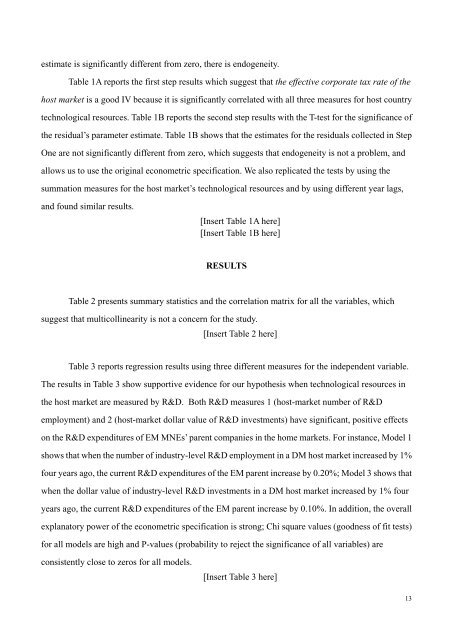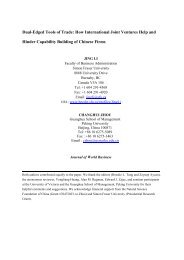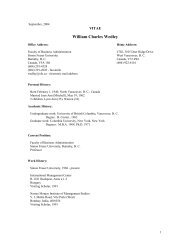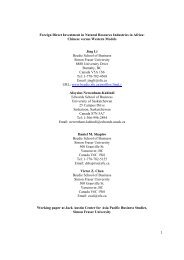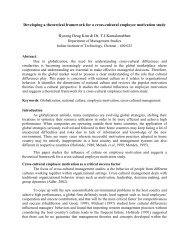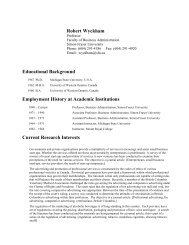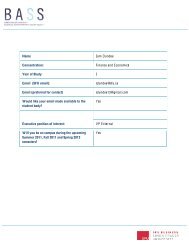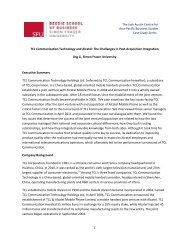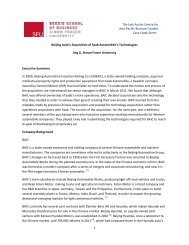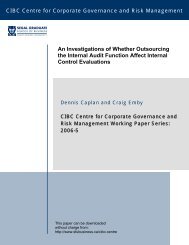Emerging-Market Multinational Enterprises in Developed Markets:
Emerging-Market Multinational Enterprises in Developed Markets:
Emerging-Market Multinational Enterprises in Developed Markets:
Create successful ePaper yourself
Turn your PDF publications into a flip-book with our unique Google optimized e-Paper software.
estimate is significantly different from zero, there is endogeneity.<br />
Table 1A reports the first step results which suggest that the effective corporate tax rate of the<br />
host market is a good IV because it is significantly correlated with all three measures for host country<br />
technological resources. Table 1B reports the second step results with the T-test for the significance of<br />
the residual’s parameter estimate. Table 1B shows that the estimates for the residuals collected <strong>in</strong> Step<br />
One are not significantly different from zero, which suggests that endogeneity is not a problem, and<br />
allows us to use the orig<strong>in</strong>al econometric specification. We also replicated the tests by us<strong>in</strong>g the<br />
summation measures for the host market’s technological resources and by us<strong>in</strong>g different year lags,<br />
and found similar results.<br />
[Insert Table 1A here]<br />
[Insert Table 1B here]<br />
RESULTS<br />
Table 2 presents summary statistics and the correlation matrix for all the variables, which<br />
suggest that multicoll<strong>in</strong>earity is not a concern for the study.<br />
[Insert Table 2 here]<br />
Table 3 reports regression results us<strong>in</strong>g three different measures for the <strong>in</strong>dependent variable.<br />
The results <strong>in</strong> Table 3 show supportive evidence for our hypothesis when technological resources <strong>in</strong><br />
the host market are measured by R&D. Both R&D measures 1 (host-market number of R&D<br />
employment) and 2 (host-market dollar value of R&D <strong>in</strong>vestments) have significant, positive effects<br />
on the R&D expenditures of EM MNEs’ parent companies <strong>in</strong> the home markets. For <strong>in</strong>stance, Model 1<br />
shows that when the number of <strong>in</strong>dustry-level R&D employment <strong>in</strong> a DM host market <strong>in</strong>creased by 1%<br />
four years ago, the current R&D expenditures of the EM parent <strong>in</strong>crease by 0.20%; Model 3 shows that<br />
when the dollar value of <strong>in</strong>dustry-level R&D <strong>in</strong>vestments <strong>in</strong> a DM host market <strong>in</strong>creased by 1% four<br />
years ago, the current R&D expenditures of the EM parent <strong>in</strong>crease by 0.10%. In addition, the overall<br />
explanatory power of the econometric specification is strong; Chi square values (goodness of fit tests)<br />
for all models are high and P-values (probability to reject the significance of all variables) are<br />
consistently close to zeros for all models.<br />
[Insert Table 3 here]<br />
13


